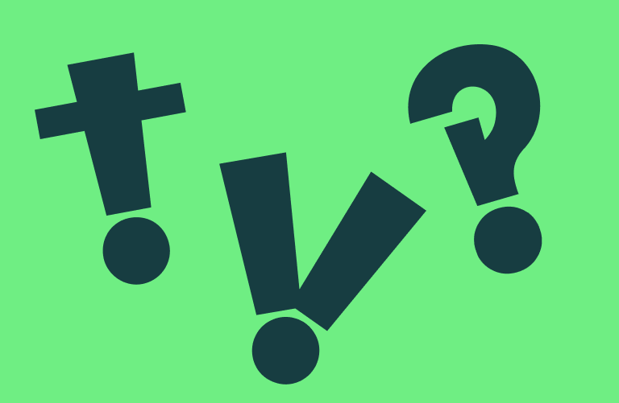

Contents
1. The interrobang
Arguably the best-named punctuation marks out there. Kudos to Martin K. Speckter for coming up with this one.

What’s the interrobang?
The interrobang is a combination of the question mark (?) and the exclamation mark (!). This lovely term comes from mashing together the 8th-century word for question mark (punctus interrogativus) with the slang term for the exclamation mark (bang). It was a close call though; the creators experimented with calling it the ‘quesclamation mark’ instead. Not nearly as catchy.
How do I use the interrobang?
You’re probably already using ‘?!’ or ‘!?’ in your writing. A question mark and an exclamation mark are usually used together to express excitement, surprise, or disbelief. The interrobang was invented to combine these marks to save space and precious characters. Why use two punctuation marks when you could use a single, super-cool one?
Example of the interrobang punctuation point in use: Ever heard of the interrobang‽
2. The snark mark
Say goodbye to awkward, misunderstood sarcasm over text.

What is the snark mark?
The snark mark, or irony mark, was created to signpost all kinds of sarcasm. The backward question mark has undergone many stylistic tweaks since it was first created in 1899. However, dig deep enough and you’ll find writers way back in 1575 complaining about not having a way of showing irony in writing. Clearly, the awkwardness of misread irony has been around for a really long time.
How do I use the snark mark?
Using the snark mark is very straightforward. Choose it whenever you want to mark sarcasm in your writing or make it clear you’re not being serious. The backward question mark is particularly useful for making sure your rhetorical questions are not taken literally, or that your written sarcasm keeps its witty edge.
Example of the snark mark in use: Excited to read another static PDF report⸮
3. The manicule
A handy way of signposting your content.

What’s the manicule?
The manicule is the ultimate blast from the past. Take a look at medieval manuscripts, and you’ll see tiny hands drawn in the margins of the page. Why? To point out the most important parts of a piece of writing. The tiny hands were so useful that they became standardized punctuation marks. They were given loads of nicknames too, including the printer’s fist, bishop’s fist, digit, and mutton-fist.
How do I use the manicule?
Manicule-up your content to make it clearer for people to pick out the most important parts of the text. Think of it as a way of highlighting the key points for your reader when you don’t want to use a feature box or basic arrow.
Example of the manicule punctuation mark in use: Read on to see why manicules are the way forward ☞
4. The certitude point
An exclamation mark that’s really sure of itself.

What’s the certitude point?
The certitude point is the equivalent of saying “no further questions” at the end of a sentence. The symbol looks like an exclamation mark crossed with a hyphen and was born in the same era as its sibling punctuation point, the snark mark. Its purpose: to show absolute certainty.
How do I use the certitude point?
Use this punctuation when you’re talking about something you want to indicate needs no further explanation or discussion. The next time you’re stating something and want to add extra emphasis, choose the certitude point.
Example of the certitude point in use: Turtl Docs are scientifically better than other content formats!̶
5. The acclamation point
An exclamation mark that never lets you down.

What’s the acclamation point?
This is one of the friendliest, most unusual punctuation marks out there. The acclamation point was invented by Hervé Bazin in 1966 to express kindness and familiarity. The shape of the mark – two exclamation marks sharing a point – is said to resemble the two flags on the front of an important figure’s car.
How do I use the acclamation point?
The acclamation point is perfect for special occasions when you want to emphasize the welcoming and friendly nature of your written content. Anytime you want to show good intentions in your writing, the acclamation point is your go-to guy.
Example of the acclamation point in use: Welcome to your new content creation tool ![]()
Why use unusual punctuation marks?
Thinking creatively by using unusual punctuation marks is just the beginning ¦⌫☙⚖⚙✓✗✭↪↜➩⬐⬳
Exotic punctuation might just be your ticket to superior and concise content. In fact, attention-grabbing punctuation, visuals, and formats might just help you:
- Give your writing an original twist
- Bring more personality to the mix
- Better signpost your messaging
- Set your content apart from the crowd
Here’s your free guide to attention marketing
Learn more about capturing engagement with your content.
Get attention with Turtl
Make a point with content you can't ignore.
Interactivity, personalization, and psychology-led layouts make readers stop, stare – and sign up for more.


